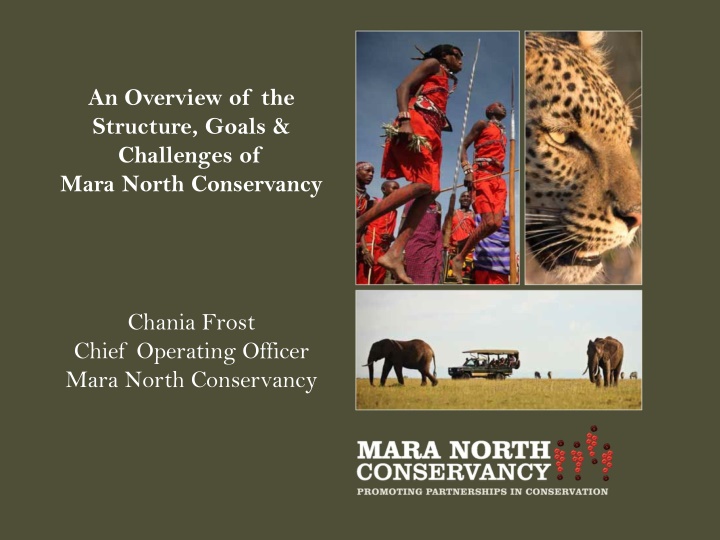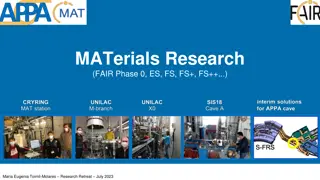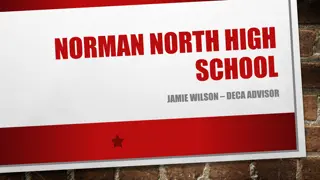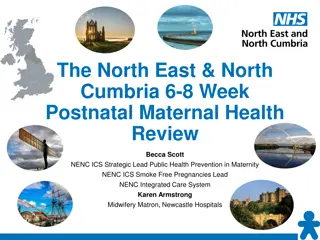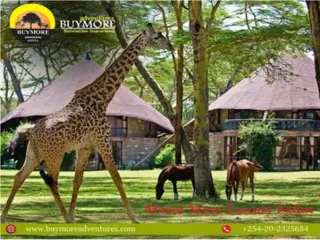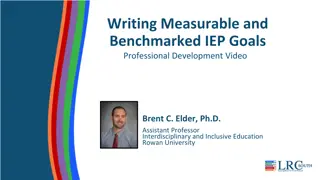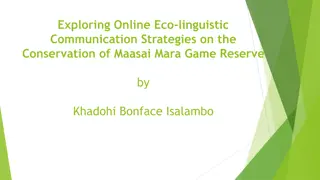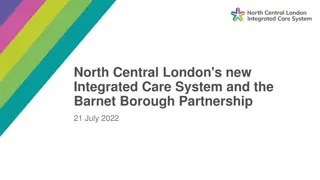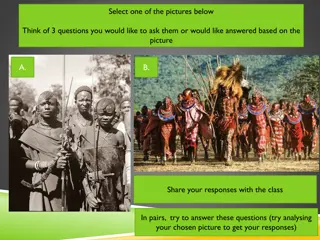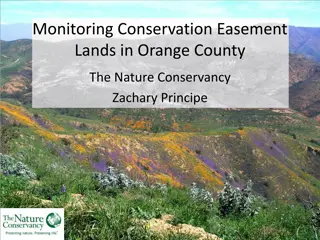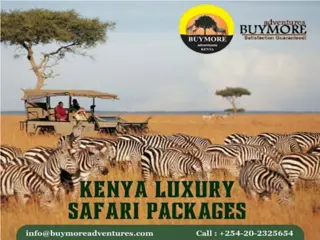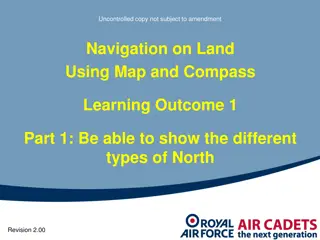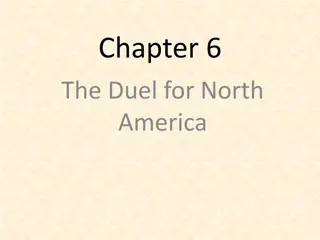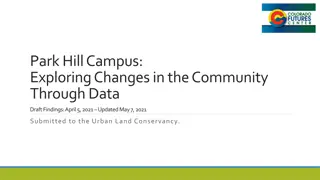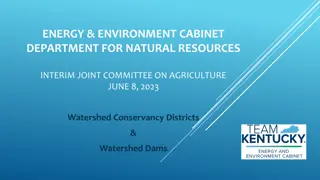Structure, Goals & Challenges of Mara North Conservancy
This overview delves into the structure, goals, and challenges faced by Mara North Conservancy, led by Chania Frost, the Chief Operating Officer. It highlights the vision of creating a sustainable wildlife conservancy and the impact of conservancies on the region. The key buffer zone initiatives such as the Mara Lion Project and Gnu Landscape Project are also discussed, along with the evolution of conservancy area and land tenure. The formation process involving community sensitization and financial inputs is detailed, emphasizing the collaboration required for successful conservation efforts.
Download Presentation

Please find below an Image/Link to download the presentation.
The content on the website is provided AS IS for your information and personal use only. It may not be sold, licensed, or shared on other websites without obtaining consent from the author.If you encounter any issues during the download, it is possible that the publisher has removed the file from their server.
You are allowed to download the files provided on this website for personal or commercial use, subject to the condition that they are used lawfully. All files are the property of their respective owners.
The content on the website is provided AS IS for your information and personal use only. It may not be sold, licensed, or shared on other websites without obtaining consent from the author.
E N D
Presentation Transcript
An Overview of the Structure, Goals & Challenges of Mara North Conservancy Chania Frost Chief Operating Officer Mara North Conservancy
VISION To create a professionally managed, world class wildlife conservancy which is sustained by member camps tourism operations.
CONSERVANCIES 11 key (+7 forming) conservancies est. since 2005 135,000Ha = 85% MMNR Directly benefitting 11,300 landowners 42 tourism properties 1,300 employees in tourism 358 employed rangers/scouts
CONSERVANCIES KEY BUFFER ZONE Data from the Mara Lion Project Niels Mogensen BSc Biology, University of Aarhus Launched the MLP in 2011 in partnership with the Danish Zoological Society Mara Lion Project | Quarterly report January April 2014
CONSERVANCIES KEY BUFFER ZONE Mara Lion Project | Quarterly report January April 2014
CONSERVANCIES KEY BUFFER ZONE Gnu Landscape Project 15 wildebeest collared GPS coordinates 16 times per day Tracked from 19 to 964 days (2.6 years) Started May 2010 2014 Stabach, J and Boone, R. Natural Resource Ecology Laboratory, Colorado State University
CONSERVANCY AREA & LAND TENURE CHANGE Subdivision started in 1984 with the Talek area directly on the MMNR border. Subdivision occurred in at least 3 separate rounds over a period of 25 years.
The process was complete by late 2009 Individual title deeds were issued to all landowners Average size parcel 50-60Ha
FORMATION OF MNC Community sensitisation process Initial input of around KES 10M or USD 115,000 Involved dozens of community meetings, transport of community members to meetings, food and drink Took 12 months 806 leases signed & bank accounts set up
COMMUNITY COLLABORATION MNC realises that the economic development and prosperity of the landowners is inextricably linked to MNC s success.
COMMUNITY COLLABORATION Co-management with the LOC Transparent payments direct to individuals bank accounts Predator compensation program Fundraising for community projects Cohesive cross- conservancy approach
GOALS OF MNC Ecosystem management & wildlife conservation Economic prosperity & Community Empowerment Excellent tourism product world class wildlife conservancy SUSTAINABILITY
CHALLENGES UNDERMINING SUSTAINABILITY SUBDIVISION OF LAND PARCELS, ILLEGAL SUBDIVISION & SALE OF LAND DEVELOPMENT OF ADDITIONAL TOURISM PROPERTIES SHOAT ENCROACHMENT, LAND DEGRADATION & WILDLIFE DISTURBANCE SETTLEMENT, FENCING TOURISM DECLINE DUE TO SECURITY INCIDENTS & EBOLA POACHING & HUMAN- WILDLIFE CONFLICT & CULTIVATION
PROGRAMS UNDERWAY Livestock management Conservation education programs Maasai Pride Campaign Financial sustainability workshops & analysis Joint planning effort across the Maasai Mara wildlife conservancies Mara ecosystem planning NRMPs including Community-Based Natural Resource Management (CBNRM) Leadership & governance training
MANAGEMENT STRUCTURE Researchers Maasai Mara Wildlife Conservancies Association MNC Tourism Partners 12 Directors MNC Landowner Committee 30 Members, 4 Leaders MNC Conservancy Management Company MNC Community Programs
CURRENT RESEARCH TEAMS Name Claire Bedelian Niels Mogensen Dr. Laurence Frank, Nicholas Elliot Institution/Supervisor ILRI, CGIAR, UCL University of Copenhagen University of California Berkley Project Community, Economic benefits of Conservancies PhD Mara-Nabiosh Lion Project Mara Predator Project Dr. Kay Holekamp & Co Connor Jandreau Dr. Bilal Butt Dickson Kaelo Michigan State University University of Manitoba University of Michigan University of Nairobi-Centre for Sustainable Dryland Ecosystem and Societies University of Edinburgh Mara Hyena Project Cattle/Community/Conservancies Livestock, Political Ecology Land Use Crystal Courtney Grassroots interpretations of development in Koiyaki, Maasai Mara, Kenya, and its perceived relationship with the Koiyaki Conservancies-PhD Gnu Landscapes Robin Reid, Jeff Worden, Jared Stabach Colorado State University Christopher Dutton Yale University Mara River http://maraadventure.blogspot.ca/ Femke Dr. Ian Douglas Hamilton, Mark Goss Oxford KWT Save the Elephants Maasai Mara Cheetah Project Mara Elephant Project - Elephant movements, behaviour Cara Steger University of Michigan Citizen Science methods can be reliable alternatives to conventional wildlife monitoring Loita Forest Everything so many papers Mariam Olivia Westervelt Joseph Ogutu ILRI, Katherine Homewood UCL Institute of Crop Science, University of Hohenheim, Germany ILRI University of Hohenheim, Germany Political ecology approach to explore gender in payments for ecosystem service schemes Mohamed Said Juliet Kariuki Livelihoods, wildlife, DRSRS data
Maasai Mara Wildlife Conservancies Association Applied Research and Informatics Program (AR&I) Vision To transform the accessibility, usefulness and application of existing and new research findings, relating to the Masai Mara landscape. 1. Best Available Knowledge social, economic, ecological 2. Strong Academic Partnerships Academic Council 3. New Knowledge - Regional Data Collection and Monitoring Program 4. Best Practice Evaluating the Evidence 5. Communication Pathway to Impact Research started under this program: Research on population increase and settlement management Research on Up-skilling youth Research on Motivational belief and value systems
WHAT WE NEED Specific management decisions and challenges require evidence-based decision-making, especially in light of serious challenges & fragility of the model Require assistance, support & collaboration on researching & monitoring priority areas, e.g. Population and settlement patterns Vegetation and biomass trends Key wildlife species indicators, impact of various programs on poaching Land tenure dynamics Livestock economics Education and employment levels Gender, culture, and religion Human-wildlife conflict Others ? Key research findings need to be shared with implementing organisations and feed into management decision-making Work with us!
VISION To create a professionally managed, world class wildlife conservancy which is sustained by member camps tourism operations.
